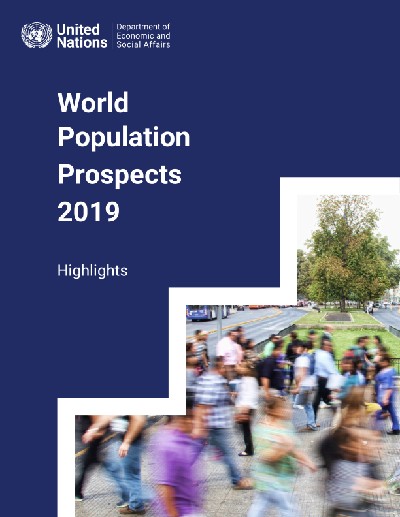"世界人类健康数据报告"相关数据
更新时间:2022-12-302019年世界人口展望
Understanding global population trends and anticipating the demographic changes to come are crucial to the achievement of the 2030Agenda for Sustainable Development. The 2030Agenda emphasizes that people are at the centre of sustainable development,echoing the ideals set forth in the Programme of Action of the International Conference on Population and Development adopted in Cairo in 1994.Population trends observed over the past few decades point to substantial progress made towards several of the Sustainable Development Goals (SDGs) so far.Examples include reduced mortality,particularly among children,as well as increased access to sexual and reproductive health care and enhanced gender equality that have empowered women to decide freely and responsibly the number,spacing and timing of their children.
Recent demographic trends are harbingers of the future challenges to sustainable development. For example,countries experiencing rapid population growth,most of which are in sub-Saharan Africa,must provide schooling and health care to growing numbers of children,and ensure education and employment opportunities to increasing numbers of youth. Countries where population growth has slowed or stopped must prepare for an increasing proportion of older persons and, in some cases,decreasing population size. These and other challenges can be addressed in part by anticipating coming demographic trends and incorporating that information into policies and planning.
The United Nations population estimates and projections form a comprehensive set of demographic data to assess population trends at the global, regional and national levels. They are used in the calculation of many of the key development indicators commonly used by the United Nations system,including for more than one third of the indicators used to monitor progress towards the achievement of the sDGs. The 2019 revision of the World Population Prospects is the twenty-sixth edition of the United Nations population estimate sand projections,which have been prepared since1951 by the Population Division of the Department of Economic and Social Affairs.The 2019 revision presents population estimates from 1950 until the present for 235 countries or areas, which have been developed through country-specific analyses of historical demographic trends. It builds on previous revisions by incorporating additional results from the 2010 and 2020 rounds of national population censuses as well as information from vital registration and recent nationally representative household surveys.The 2019 revision also presents population projections to the year 2100 that reflect a range of plausible outcomes at the global, regional and country levels.
【更多详情,请下载:2019年世界人口展望】

 2006-2019年全球受访国家没有健康保险[男性]的调查统计数据本数据记录了2006-2019年全球受访国家没有健康保险[男性]的调查统计数据。调查内容为没有医疗保险的男性百分比。2006-2019年发布时间:2021-01-27
2006-2019年全球受访国家没有健康保险[男性]的调查统计数据本数据记录了2006-2019年全球受访国家没有健康保险[男性]的调查统计数据。调查内容为没有医疗保险的男性百分比。2006-2019年发布时间:2021-01-27 2004-2019年全球受访国家没有健康保险[女性]的调查统计数据本数据记录了2004-2019年全球受访国家没有健康保险[女性]的调查统计数据。调查内容为没有医疗保险的女性百分比。2004-2019年发布时间:2021-01-20
2004-2019年全球受访国家没有健康保险[女性]的调查统计数据本数据记录了2004-2019年全球受访国家没有健康保险[女性]的调查统计数据。调查内容为没有医疗保险的女性百分比。2004-2019年发布时间:2021-01-20 2005-2019年全球受访国家社会保障健康保险[妇女]的调查统计数据本数据记录了2005-2019年全球受访国家社会保障健康保险[妇女]的调查统计数据。调查内容为拥有社会保障健康保险的妇女百分比。2005-2019年发布时间:2021-01-20
2005-2019年全球受访国家社会保障健康保险[妇女]的调查统计数据本数据记录了2005-2019年全球受访国家社会保障健康保险[妇女]的调查统计数据。调查内容为拥有社会保障健康保险的妇女百分比。2005-2019年发布时间:2021-01-20 2006-2019年全球受访国家社会保障健康保险[男性]的调查统计数据本数据记录了2006-2019年全球受访国家社会保障健康保险[男性]的调查统计数据。调查内容为拥有社会保障健康保险的男性百分比。2006-2019年发布时间:2021-01-20
2006-2019年全球受访国家社会保障健康保险[男性]的调查统计数据本数据记录了2006-2019年全球受访国家社会保障健康保险[男性]的调查统计数据。调查内容为拥有社会保障健康保险的男性百分比。2006-2019年发布时间:2021-01-20 1994-2017年全球受访国家关于指标“不打算使用避孕的原因:健康问题”的调查统计数据本数据记录了1994-2017年全球受访国家关于指标“不打算使用避孕的原因:健康问题”的调查统计数据。调查内容为未使用避孕方法且由于健康原因不打算在未来使用的目前已婚或同居妇女的百分比。1994-2017年发布时间:2021-01-20
1994-2017年全球受访国家关于指标“不打算使用避孕的原因:健康问题”的调查统计数据本数据记录了1994-2017年全球受访国家关于指标“不打算使用避孕的原因:健康问题”的调查统计数据。调查内容为未使用避孕方法且由于健康原因不打算在未来使用的目前已婚或同居妇女的百分比。1994-2017年发布时间:2021-01-20 1980-2017年全球190个国家人类发展指数人类发展指数(HDI)是衡量人类发展关键方面平均成就的汇总指标:寿命长,健康,知识渊博且生活水平良好。1980-2017年发布时间:2020-07-06
1980-2017年全球190个国家人类发展指数人类发展指数(HDI)是衡量人类发展关键方面平均成就的汇总指标:寿命长,健康,知识渊博且生活水平良好。1980-2017年发布时间:2020-07-06 1990-2014年全球187个国家和地区人类发展指数HDI的创建是为了强调人和他们的能力应该是评估一个国家发展的最终标准,而不仅仅是经济增长。人类发展指数也可以用来质疑国家的政策选择,询问人均国民总收入水平相同的两个国家如何才能获得不同的人类发展成果。这些对比可以激起有关政府政策重点的辩论。 人类发展指数(HDI)是衡量人类发展关键方面平均成就的汇总指标:寿命长,健康,知识渊博且生活水平良好。 HDI是三个维度中每个维度的归一化指标的几何平均值。1990-2014年发布时间:2020-07-06
1990-2014年全球187个国家和地区人类发展指数HDI的创建是为了强调人和他们的能力应该是评估一个国家发展的最终标准,而不仅仅是经济增长。人类发展指数也可以用来质疑国家的政策选择,询问人均国民总收入水平相同的两个国家如何才能获得不同的人类发展成果。这些对比可以激起有关政府政策重点的辩论。 人类发展指数(HDI)是衡量人类发展关键方面平均成就的汇总指标:寿命长,健康,知识渊博且生活水平良好。 HDI是三个维度中每个维度的归一化指标的几何平均值。1990-2014年发布时间:2020-07-06 1999-2019年全球受访国家对艾滋病没有错误的看法-健康的人可以感染艾滋病病毒[妇女]的调查统计数据本数据记录了1999-2019年全球受访国家对艾滋病没有错误的看法-健康的人可以感染艾滋病病毒[妇女]的调查统计数据。调查内容为表示健康的人可以感染艾滋病毒的女性百分比。。1999-2019年发布时间:2021-01-27
1999-2019年全球受访国家对艾滋病没有错误的看法-健康的人可以感染艾滋病病毒[妇女]的调查统计数据本数据记录了1999-2019年全球受访国家对艾滋病没有错误的看法-健康的人可以感染艾滋病病毒[妇女]的调查统计数据。调查内容为表示健康的人可以感染艾滋病毒的女性百分比。。1999-2019年发布时间:2021-01-27 1990-2019年全球受访国家关于指标“因副作用,健康第一年避孕药停用率”的调查统计数据本数据记录了1990-2019年全球受访国家关于指标“因副作用,健康第一年避孕药停用率”的调查统计数据。调查内容为在调查前的五年内开始使用避孕药具的妇女中,由于副作用,健康而在12个月内停止使用避孕药具的百分比。1990-2019年发布时间:2021-01-20
1990-2019年全球受访国家关于指标“因副作用,健康第一年避孕药停用率”的调查统计数据本数据记录了1990-2019年全球受访国家关于指标“因副作用,健康第一年避孕药停用率”的调查统计数据。调查内容为在调查前的五年内开始使用避孕药具的妇女中,由于副作用,健康而在12个月内停止使用避孕药具的百分比。1990-2019年发布时间:2021-01-20 1999-2019年全球受访国家没有关于艾滋病的错误信念-健康的人可以感染艾滋病病毒[男人]的调查统计数据本数据记录了1999-2019年全球受访国家没有关于艾滋病的错误信念-健康的人可以感染艾滋病病毒[男人]的调查统计数据。调查内容为表示健康的人可以感染AIDS病毒的男性百分比。。1999-2019年发布时间:2021-01-20
1999-2019年全球受访国家没有关于艾滋病的错误信念-健康的人可以感染艾滋病病毒[男人]的调查统计数据本数据记录了1999-2019年全球受访国家没有关于艾滋病的错误信念-健康的人可以感染艾滋病病毒[男人]的调查统计数据。调查内容为表示健康的人可以感染AIDS病毒的男性百分比。。1999-2019年发布时间:2021-01-20 2019年10月中国教育行业融资数据报告该数据为2019年10月国内教育行业的融资数据,包含了投资金额、投资轮次、地域分布、融资体量、细分领域等。2019年发布时间:2020-01-09
2019年10月中国教育行业融资数据报告该数据为2019年10月国内教育行业的融资数据,包含了投资金额、投资轮次、地域分布、融资体量、细分领域等。2019年发布时间:2020-01-09 2019年9月中国教育行业融资数据报告该数据为2019年9月国内教育行业的融资数据,包含了投资金额、投资轮次、地域分布、融资体量、细分领域等。2019年发布时间:2020-01-09
2019年9月中国教育行业融资数据报告该数据为2019年9月国内教育行业的融资数据,包含了投资金额、投资轮次、地域分布、融资体量、细分领域等。2019年发布时间:2020-01-09 2019年8月中国教育行业融资数据报告该数据为2019年8月国内教育行业的融资数据,包含了投资金额、投资轮次、地域分布、融资体量、细分领域等。2019年发布时间:2020-01-09
2019年8月中国教育行业融资数据报告该数据为2019年8月国内教育行业的融资数据,包含了投资金额、投资轮次、地域分布、融资体量、细分领域等。2019年发布时间:2020-01-09 2019年7月中国教育行业融资数据报告该数据为2019年7月国内教育行业的融资数据,包含了投资金额、投资轮次、地域分布、融资体量、细分领域等。2019年发布时间:2020-01-09
2019年7月中国教育行业融资数据报告该数据为2019年7月国内教育行业的融资数据,包含了投资金额、投资轮次、地域分布、融资体量、细分领域等。2019年发布时间:2020-01-09 1995-2014年全球235个国家和地区家庭自己支付的健康支出占健康总支出的百分比该数据包含了1995-2014年全球235个国家和地区家庭自己支付的健康支出占健康总支出的百分比。中国1995年为46.40008838%,1996年为50.64362465%,1997年为52.83829601%,1998年为54.84569492%,1999年为55.85054933%。1995-2014年发布时间:2020-07-10
1995-2014年全球235个国家和地区家庭自己支付的健康支出占健康总支出的百分比该数据包含了1995-2014年全球235个国家和地区家庭自己支付的健康支出占健康总支出的百分比。中国1995年为46.40008838%,1996年为50.64362465%,1997年为52.83829601%,1998年为54.84569492%,1999年为55.85054933%。1995-2014年发布时间:2020-07-10 2018年世界各国人口总数统计该统计数据包含了2018年世界各国人口总数统计。中国作为世界人口第一大国,2018年的总人口数量为13.93亿人,占比世界人口总量的18.34%。2018年发布时间:2020-07-03
2018年世界各国人口总数统计该统计数据包含了2018年世界各国人口总数统计。中国作为世界人口第一大国,2018年的总人口数量为13.93亿人,占比世界人口总量的18.34%。2018年发布时间:2020-07-03 1979-2017年全球161个国家世界银行估计的基尼系数基尼系数衡量的是经济体内个人或家庭之间的收入分配(或在某些情况下为消费支出)偏离完全均等分配的程度。基尼系数为0表示完全平等,而指数100则表示完全不平等。1979-2017年发布时间:2020-07-02
1979-2017年全球161个国家世界银行估计的基尼系数基尼系数衡量的是经济体内个人或家庭之间的收入分配(或在某些情况下为消费支出)偏离完全均等分配的程度。基尼系数为0表示完全平等,而指数100则表示完全不平等。1979-2017年发布时间:2020-07-02 2007-2017年全球198个国家和地区世界经济论坛(WEF)的海关手续负担打分该数据包含了2007-2017年全球198个国家和地区世界经济论坛(WEF)的海关手续负担打分。阿拉伯联盟国家2017年为4.08571428571429(1=效率极低,7=效率极高),2016年为4.11538461538462(1=效率极低,7=效率极高),2015年为4.12135312920992(1=效率极低,7=效率极高),2014年为3.94666666666667(1=效率极低,7=效率极高),2013年为4.10666666666667(1=效率极低,7=效率极高)。2007-2017年发布时间:2020-11-30
2007-2017年全球198个国家和地区世界经济论坛(WEF)的海关手续负担打分该数据包含了2007-2017年全球198个国家和地区世界经济论坛(WEF)的海关手续负担打分。阿拉伯联盟国家2017年为4.08571428571429(1=效率极低,7=效率极高),2016年为4.11538461538462(1=效率极低,7=效率极高),2015年为4.12135312920992(1=效率极低,7=效率极高),2014年为3.94666666666667(1=效率极低,7=效率极高),2013年为4.10666666666667(1=效率极低,7=效率极高)。2007-2017年发布时间:2020-11-30 2019年上半年1-6月中国教育行业融资数据报告该数据为2019年上半年1月-6月国内教育行业的融资数据,包含了投资金额、投资轮次、地域分布、融资体量、细分领域等。2019年发布时间:2020-01-09
2019年上半年1-6月中国教育行业融资数据报告该数据为2019年上半年1月-6月国内教育行业的融资数据,包含了投资金额、投资轮次、地域分布、融资体量、细分领域等。2019年发布时间:2020-01-09 2018年中国各年龄层喜欢使用的表情该统计数据包含了2018年中国各年龄层喜欢使用的表情。00后最喜欢使用捂脸表情。2018年发布时间:2020-07-09
2018年中国各年龄层喜欢使用的表情该统计数据包含了2018年中国各年龄层喜欢使用的表情。00后最喜欢使用捂脸表情。2018年发布时间:2020-07-09





